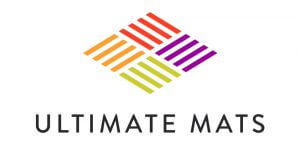
What to Look for When Buying an Anti-Fatigue Mat
Creating a comfortable and health-conscious workspace is essential, especially for those with considerable time standing. We should know, because at Ultimate Mats, we’ve been supplying anti-fatigue mats for decades.
Whether it’s at a kitchen sink, a standing desk, or on an industrial floor, the right anti-fatigue mat can significantly reduce stress, discomfort and the risk of long-term health issues. However, selecting the perfect standing mat requires understanding what features contribute most to comfort, durability, and overall effectiveness.
In this article, you will learn:
- The importance of thickness and material in anti-fatigue mats.
- How size and shape affect the usability of a standing mat.
- Additional features to consider for enhanced comfort and durability.
With the correct information, choosing a standing mat that meets your specific needs can be straightforward and rewarding. Let’s dive into what makes an anti-fatigue mat stand out.
Importance of Thickness and Material
When it comes to anti-fatigue mats, the thickness and material are not just details—they’re crucial to the mat’s performance and your comfort. A mat that’s too thin might not provide enough cushioning, leading to little relief from the floor’s hardness. Conversely, a mat that’s too thick could cause instability and tripping hazards. The sweet spot for most high-quality anti-fatigue mats is between 3/4 inch to 1 inch. This thickness offers a balance between softness for comfort and firmness for support, ensuring that your body isn’t overly strained.
The material of the standing mat plays a significant role in its effectiveness and longevity. Generally, these mats are made from one of three materials: rubber, foam or bio-foam, and gel.
- Rubber: Rubber mats are durable and offer excellent resistance to wear and tear. They’re ideal for environments where the mat might be exposed to liquids or chemicals, such as kitchens or industrial areas. However, they can be on the firmer side, which might not be ideal for all-day comfort in some cases.
- Foam: Foam mats provide excellent cushioning, making them a great choice for standing desks or retail positions where comfort is a priority. They can vary in density, with higher-density foam or bio-foam offering a good balance of comfort and support. Foam mats are one of the best budget-friendly options, but they might not be as durable as rubber mats, especially in high-traffic areas.
- Gel: Gel mats are known for their superior comfort and support. They can be especially beneficial for individuals with joint pain or those who need extra cushioning. While gel mats can offer an unparalleled level of comfort, they often come at a higher price point and may require more care to maintain.
Choosing the right material and thickness depends on your specific needs, including the amount of time you spend standing, the environment in which the mat will be used, and any personal preferences for cushioning and support.
In the next section, we’ll explore how the size and shape of anti-fatigue mats can further influence their suitability for your workspace.
Size and Shape: Fit Your Workspace
Anti-fatigue mats are available in varying sizes and shapes. Choosing the right size and shape for your mat is just as important as selecting the proper material and thickness. The goal is to cover enough space to move comfortably without stepping off the mat frequently, which can disrupt the ergonomic benefits and potentially lead to tripping hazards.
Workspace Size: Consider the dimensions of your workspace. A mat that’s too small limits your movement and may not provide relief in all the standing positions you adopt throughout the day. For example, a larger mat or a set of anti-fatigue kitchen mats that cover more ground can be more beneficial, as you will move around a lot in this area.
Shape: Anti-fatigue kitchen mats come in various shapes, from rectangular to contoured designs. Standard rectangles work well in most settings, but specialized shapes can offer additional benefits. For instance, a mat with a contoured or tapered edge can fit better in certain workspaces and help reduce tripping hazards.
Standing Area: Think about where you stand the most and how you move in that space. If you tend to stay in one spot for long hours, a smaller, more cushioned mat might suffice. However, if your work requires lateral movement, consider a longer mat that allows you to walk along it without stepping off.
Specific Applications:
- Office: For standing desks, a mat that fits comfortably under the desk and extends out enough for you to take a step or two can enhance your working experience.
- Kitchen: Larger, easy-to-clean anti-fatigue kitchen mats that can cover the area in front of the counter and the sink is ideal, as it accommodates shifting positions while cooking or washing dishes.
- Industrial Settings: Durable mats with resistance to oils or chemicals, covering wide areas where workers move around machinery or workstations, are critical for safety and comfort.
By carefully considering the size and shape of the standing mat, you ensure that it complements your workspace and supports your movements, enhancing overall comfort and productivity.
Now, let’s discuss additional features that can make an anti-fatigue mat even more effective for your needs.
Additional Features for Safety and Durability
Beyond the fundamental aspects of material, thickness, size, and shape, anti-fatigue kitchen mats have many benefits that can significantly enhance their utility and value. These features can improve safety, ease of maintenance, and even contribute to the longevity of the mat.
Anti-Slip Surface: Safety should always be a priority in any workspace. A standing mat with an anti-slip surface ensures stability and helps prevent accidents, especially in environments where spills are common, like kitchens or industrial areas.
Beveled Edges: Mats with beveled or tapered edges and textured surfaces greatly reduce the risk of tripping and make it easier to roll chairs or carts over them. This feature is crucial in busy environments or in spaces where the mat edges are not against a wall or under a desk.
Waterproof and Easy-to-Clean Surfaces: In environments where spills are likely, a waterproof mat that can be easily wiped clean is invaluable. This feature not only helps maintain a clean and hygienic workspace but also extends the life of the mat by preventing water damage and mold growth.
Eco-Friendly Materials: For those concerned with environmental impact, anti-fatigue kitchen mats made from recycled or sustainable materials offer a way to combine comfort with eco-consciousness. These mats often come without a significant compromise on durability or effectiveness.
Certifications for Health and Safety Standards: Mats that have been tested and certified to meet specific health and safety standards can provide peace of mind, especially in work environments where employee wellness is a priority. Look for certifications that guarantee the mat’s materials are safe and free from harmful chemicals.
By prioritizing these additional features, you can find anti-fatigue kitchen mats that not only provides the necessary support and comfort but also aligns with your specific needs and values, ensuring a safer, more convenient, and more sustainable workspace.
Having covered the essential aspects and additional features to consider when purchasing a standing mat, the next section will summarize these points and guide you on choosing the right mat for your specific needs.
Making the Best Choice for Your Anti-Fatigue Mat
In conclusion, when buying a standing mat, it’s crucial to consider:
- The importance of material and thickness for comfort and support.
- The necessity of selecting the appropriate size and shape for your workspace.
- The value of additional features like anti-slip surfaces, beveled edges, textured surfaces, and eco-friendly materials for enhanced comfort, safety, and sustainability.
Here at Ultimate Mats, we have a wide range of anti-fatigue mats that will suit your needs.
Check them out in our anti-fatigue mat section.
Thanks for reading.
FAQs
What to look for when buying an anti-fatigue mat?
Focus on material, thickness, and durability. Anti-fatigue mats are generally made from rubber, foam, or gel. Choose the material based on your needs. A thickness of ¾-1 inch provides solid support and reduces the risk of tripping. Look for beveled edges and anti-slip surfaces for increased safety, and choose a size that matches your workspace.
Are expensive anti-fatigue mats worth it?
Yes, if you stand for long periods. Premium mats last longer and offer better support, whereas cheaper or low-quality mats can flatten or crack over time. In the long term, investing in a high-quality mat can reduce discomfort and require fewer replacements, making it a smarter and more comfortable choice.
How long do anti-fatigue mats last?
The lifespan of a standing mat depends on its quality and usage. Quality anti-fatigue mats can last up to eight years, but may wear out faster if they are used in areas with heavy foot traffic. Some mats are designed to withstand continuous pressure, while others are made for more occasional use.
Are anti-fatigue mats easy to clean?
Yes, anti-fatigue mats are generally designed to be easy to clean. Rubber mats can be wiped or hosed down. Foam mats need to be cleaned gently. Don’t use harsh chemicals, as they can damage the surface.
Is it safe to use anti-fatigue mats in wet or oily areas?
Yes, if the mats are designed for it. Look for oil-resistant or waterproof mats with an anti-slip backing. Don’t use foam mats in kitchens or industrial areas. Rubber mats are ideal for those environments.
